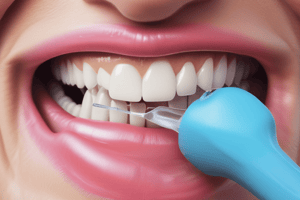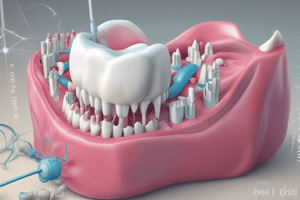Podcast
Questions and Answers
What is the routine depth recommended to be pulpal to D.E.J.?
What is the routine depth recommended to be pulpal to D.E.J.?
- 1.0-1.5 mm
- 0.2-0.5 mm (correct)
- 1.5-2.0 mm
- 0.5-1.0 mm
What should be avoided to prevent mechanical irritation of the pulp during cutting procedures?
What should be avoided to prevent mechanical irritation of the pulp during cutting procedures?
- Undercutting of enamel
- Over cutting of cementum
- Undercutting of dentin
- Over cutting of enamel (correct)
What does cutting across recessional lines of the pulp lead to?
What does cutting across recessional lines of the pulp lead to?
- Increased dentin thickness
- Pulp exposure (correct)
- Enhanced pulp protection
- Reduced caries spread
What is the purpose of decreasing the depth of the cavity?
What is the purpose of decreasing the depth of the cavity?
What may unnecessary application of pressure in scooping out soft dentine at the bottom of deep cavities lead to?
What may unnecessary application of pressure in scooping out soft dentine at the bottom of deep cavities lead to?
Flashcards are hidden until you start studying
Study Notes
Cavity Preparation
- The recommended routine depth to be pulpal to D.E.J. is 0.5 mm to 1 mm.
Preventing Mechanical Irritation
- Avoid applying excessive pressure and using dull burs to prevent mechanical irritation of the pulp during cutting procedures.
Cutting Across Recessional Lines
- Cutting across recessional lines of the pulp leads to tearing of the pulp tissue and potentially causing pulpal trauma.
Decreasing Cavity Depth
- The purpose of decreasing the depth of the cavity is to reduce the possibility of pulp exposure and minimize the risk of pulpal trauma.
Scooping Out Soft Dentine
- Unnecessary application of pressure in scooping out soft dentine at the bottom of deep cavities may lead to furcation perforation and pulpal trauma.
Studying That Suits You
Use AI to generate personalized quizzes and flashcards to suit your learning preferences.




